ART NEWS: Dec.01
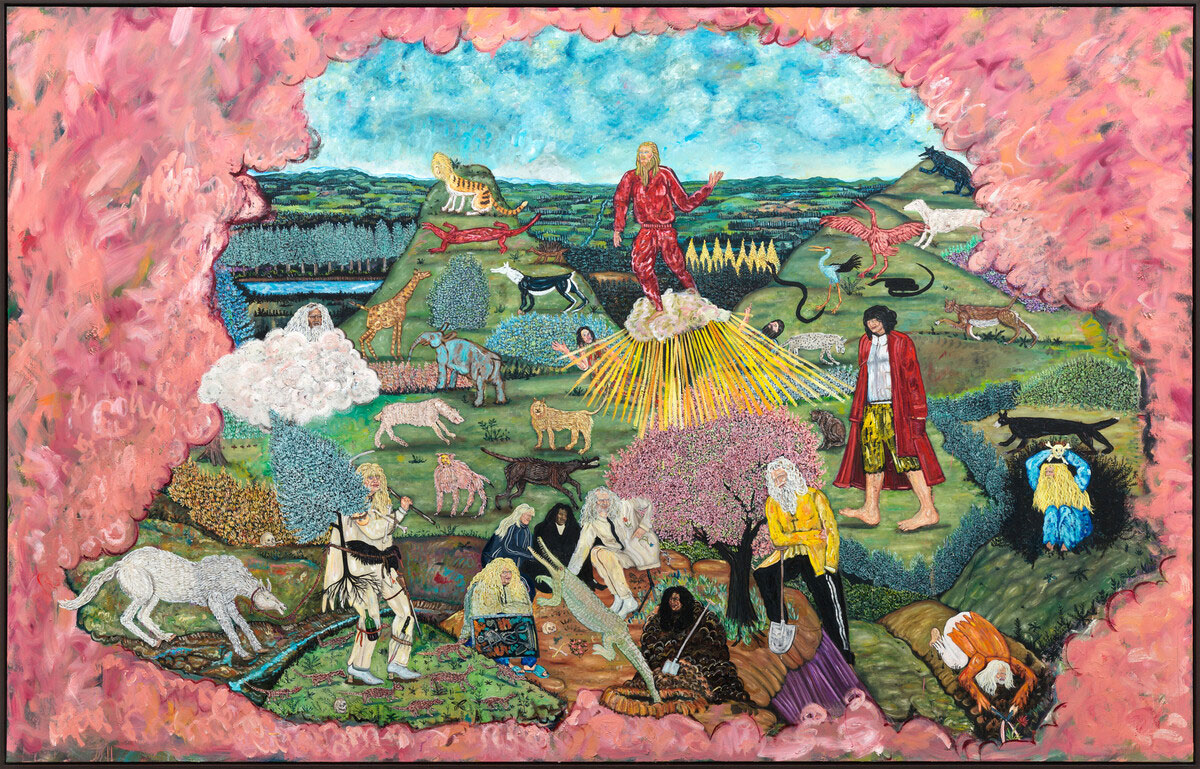 Bram Demunter presents his solo exhibition titled “Burrowers, Climbers, Crawlers”. His paintings and drawings strongly illustrate his process of collecting, examining and categorizing different elements. The artist can spend many hours studying an object, while wondering where it came from and what history it has been gone through. These objects then manage to nestle in his subconscious, establishing new connections between obscure stories, tales, legends and myths with forgotten symbolism, which he seamlessly connects to more recent events. For this exhibition, Demunter drew inspiration from obscure maps and old books, diving deep into human history in search of handed-down traces of interaction with nature. Rocks are therefore an important theme in his work, and take the form of mountains, rock formations, caves, meteorites, thereby embodying ancient symbolism. The diversity of symbols reveals the deep-rooted human fascination with nature across epochs and cultures. Instead of using maps as merely representational tools, Demunter exploits them as sources that capture the human interaction with the world. Demunter’s approach is not limited to visual compositions, but extends far beyond words: each work, whether drawn, painted or written, forms an exploratory journey, which transcends time and space; his images suspend time, as it were. Info: Tim Van Laere Gallery, Jos Smolderenstraat 50, Antwerp, Belgium, Duration: 30/11/2023-20/1/2024, Days & Hours: Tue-Sat 13:00-18:00, www.timvanlaeregallery.com/
Bram Demunter presents his solo exhibition titled “Burrowers, Climbers, Crawlers”. His paintings and drawings strongly illustrate his process of collecting, examining and categorizing different elements. The artist can spend many hours studying an object, while wondering where it came from and what history it has been gone through. These objects then manage to nestle in his subconscious, establishing new connections between obscure stories, tales, legends and myths with forgotten symbolism, which he seamlessly connects to more recent events. For this exhibition, Demunter drew inspiration from obscure maps and old books, diving deep into human history in search of handed-down traces of interaction with nature. Rocks are therefore an important theme in his work, and take the form of mountains, rock formations, caves, meteorites, thereby embodying ancient symbolism. The diversity of symbols reveals the deep-rooted human fascination with nature across epochs and cultures. Instead of using maps as merely representational tools, Demunter exploits them as sources that capture the human interaction with the world. Demunter’s approach is not limited to visual compositions, but extends far beyond words: each work, whether drawn, painted or written, forms an exploratory journey, which transcends time and space; his images suspend time, as it were. Info: Tim Van Laere Gallery, Jos Smolderenstraat 50, Antwerp, Belgium, Duration: 30/11/2023-20/1/2024, Days & Hours: Tue-Sat 13:00-18:00, www.timvanlaeregallery.com/
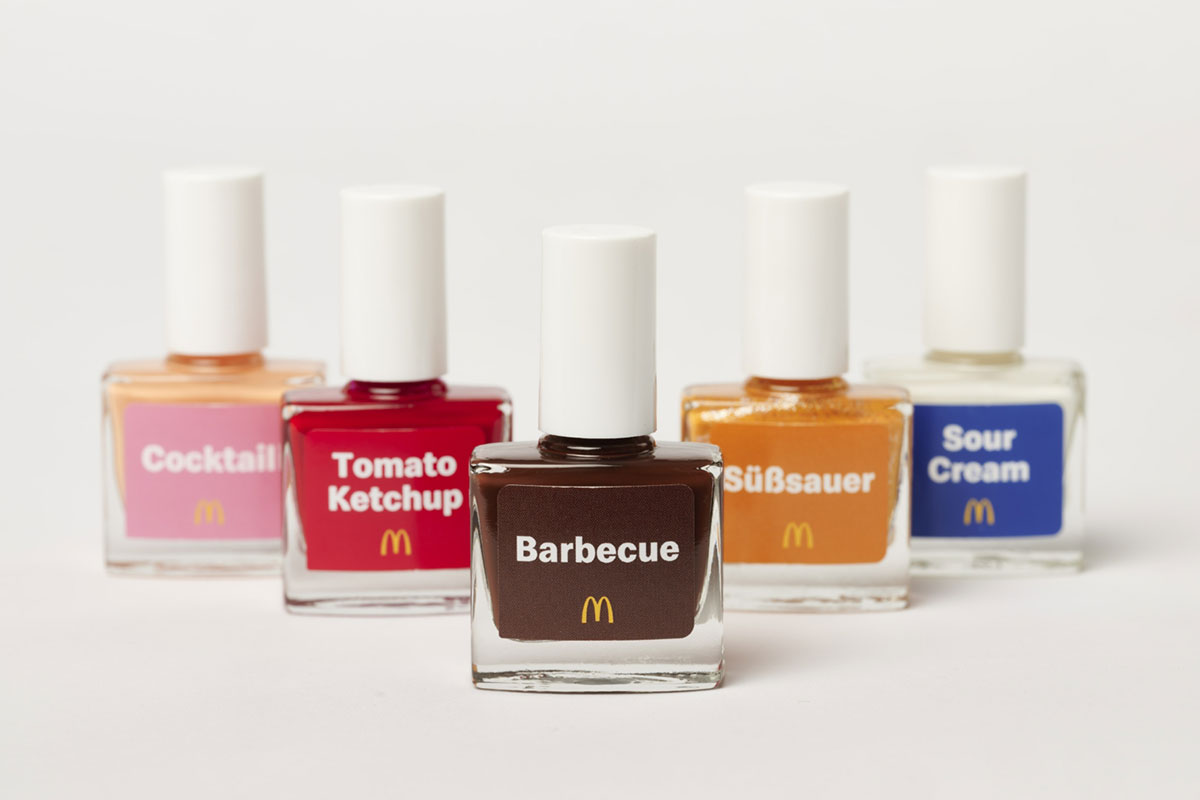 Artificial intelligence takes big steps, generative systems reach new levels of image and text production. What does it mean for painting if it can be made by calculating robots? This is the concept of the group exhibition “Hoi Cologne-Part 2: In the abdomen of the machine”. In the past, technological leaps often formed the beginning of long periods of revolutionary molts of art. Before leaps, man could still imagine, he has the privilege of being able to do something. After that, suddenly overtaken by the technology, he had to stretch to the ceiling. Impressionism was due to the interactions with the invention of photography and much in postmodern painting was inspired by experience with the computer. It is precisely the beginning of such a phase, in which man-made art has to work its way to its technological mirror. What can these machines and where do they reach their limits? With the question of how he differs from it, and the search for his niche man looks at himself through the machine. Info: Curator: Valérie Knoll, Koelnischer Kunstverein, Hahnenstraße 6, Kologne, Germany, Duration: 2/12/2023-21/1/2024, Days & Hours: Tue-Sun 11:00-18:00, https://koelnischerkunstverein.de/
Artificial intelligence takes big steps, generative systems reach new levels of image and text production. What does it mean for painting if it can be made by calculating robots? This is the concept of the group exhibition “Hoi Cologne-Part 2: In the abdomen of the machine”. In the past, technological leaps often formed the beginning of long periods of revolutionary molts of art. Before leaps, man could still imagine, he has the privilege of being able to do something. After that, suddenly overtaken by the technology, he had to stretch to the ceiling. Impressionism was due to the interactions with the invention of photography and much in postmodern painting was inspired by experience with the computer. It is precisely the beginning of such a phase, in which man-made art has to work its way to its technological mirror. What can these machines and where do they reach their limits? With the question of how he differs from it, and the search for his niche man looks at himself through the machine. Info: Curator: Valérie Knoll, Koelnischer Kunstverein, Hahnenstraße 6, Kologne, Germany, Duration: 2/12/2023-21/1/2024, Days & Hours: Tue-Sun 11:00-18:00, https://koelnischerkunstverein.de/
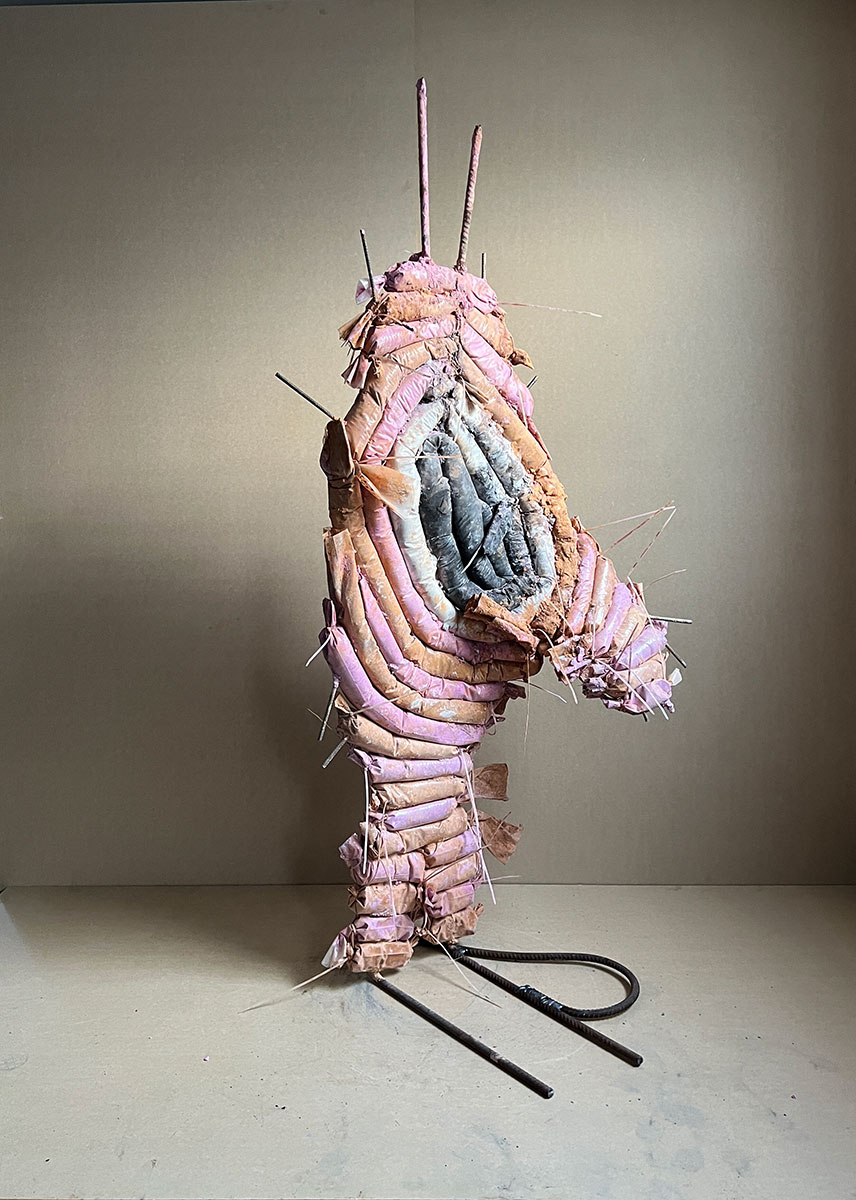 Michael Dean’s sculptures are capable of transforming the exhibition “Lamp black on sack cloth (love for fucksake)” into a theater, into an action. They remind us of characters performing a scene. A group of works, which almost seem as if they are about to climb a set of stairs, shows how characters and language are central to his work. The sculptures in the room and on the walls interact with the space, forming a perfect triangle with the observer. The organic development of the alphabets trapped in concrete forms is further exalted in this exhibition. Dean’s work always strikes a balance between form and text, predominated by materials such as concrete and paper, and this time is no different. In this first solo exhibition in the new Paris gallery space, the artist presents a series of paintings framed by concrete sculptures, subverting the paradigm of the frame itself. This unprecedented series of paintings is built upon two elements that form the basis of the artist’s works: the structure of the sculpture and dialogue with the context. The wide-mesh sack cloth evokes an analogy concerning the function of the rods, which are the skeleton of the work. In fact, paint clings to the canvas just as concrete does to the metal grid. Info: Mendes Wood DM, 25 Place des Vosges, Paris, France, Duration: 2/12/2023-20/1/2024, Days & Hours: Tue-Sat 11:00-19:00, https://mendeswooddm.com/
Michael Dean’s sculptures are capable of transforming the exhibition “Lamp black on sack cloth (love for fucksake)” into a theater, into an action. They remind us of characters performing a scene. A group of works, which almost seem as if they are about to climb a set of stairs, shows how characters and language are central to his work. The sculptures in the room and on the walls interact with the space, forming a perfect triangle with the observer. The organic development of the alphabets trapped in concrete forms is further exalted in this exhibition. Dean’s work always strikes a balance between form and text, predominated by materials such as concrete and paper, and this time is no different. In this first solo exhibition in the new Paris gallery space, the artist presents a series of paintings framed by concrete sculptures, subverting the paradigm of the frame itself. This unprecedented series of paintings is built upon two elements that form the basis of the artist’s works: the structure of the sculpture and dialogue with the context. The wide-mesh sack cloth evokes an analogy concerning the function of the rods, which are the skeleton of the work. In fact, paint clings to the canvas just as concrete does to the metal grid. Info: Mendes Wood DM, 25 Place des Vosges, Paris, France, Duration: 2/12/2023-20/1/2024, Days & Hours: Tue-Sat 11:00-19:00, https://mendeswooddm.com/
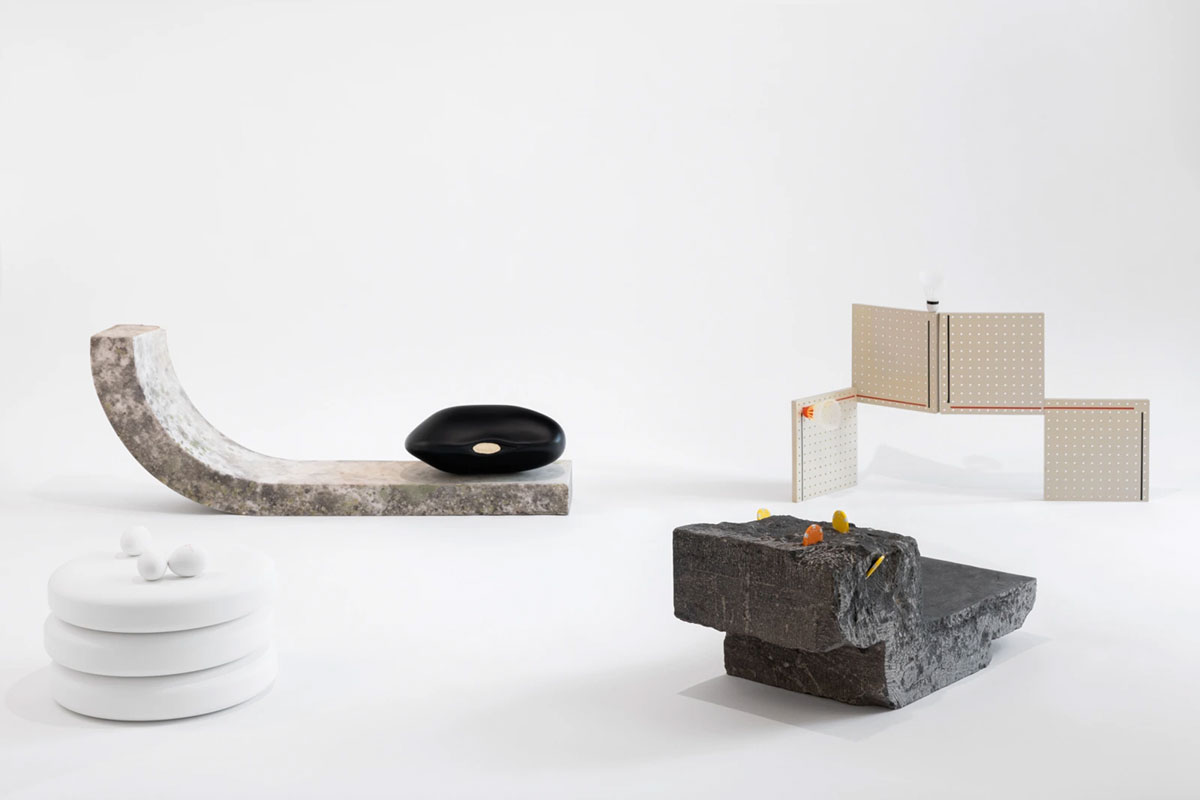 Gabriel Kuri’s in “Particules Préemptives”, his first solo exhibition in Paris, presents new works. Hisœuvre encompasses diverse media including sculpture, collage and installation, often using repurposed natural, industrial, and mass-produced objects (insulation foam, shells, soda cans, stones, or ticket receipts, for instance) to craft eloquent works of art. Traces of past human activities—among them empty bottles or cans, cigarette butts or ticket stubs—function as signs of spent time, energy or currency, a recurring theme in the artist’s work. In characteristic fashion, Kuri has developed the exhibition in response to the gallery space. Not exactly a private space but not strictly public either, Kuri’s exhibition plays with the rhythm of intimately scaled rooms, responds to their proportions and with his choice of materials echoes the vestiges of old-world elegance of gilded mirrors and marble fireplaces. Info: Esther Schipper Gallery, 16 Place Vendôme (Staircase B across the courtyard, 2nd floor to the left), Paris, France, Duration: 2/12/2023-3/2/2024, Days & Hours: Tue-Fri 11:00-18:00, www.estherschipper.com/
Gabriel Kuri’s in “Particules Préemptives”, his first solo exhibition in Paris, presents new works. Hisœuvre encompasses diverse media including sculpture, collage and installation, often using repurposed natural, industrial, and mass-produced objects (insulation foam, shells, soda cans, stones, or ticket receipts, for instance) to craft eloquent works of art. Traces of past human activities—among them empty bottles or cans, cigarette butts or ticket stubs—function as signs of spent time, energy or currency, a recurring theme in the artist’s work. In characteristic fashion, Kuri has developed the exhibition in response to the gallery space. Not exactly a private space but not strictly public either, Kuri’s exhibition plays with the rhythm of intimately scaled rooms, responds to their proportions and with his choice of materials echoes the vestiges of old-world elegance of gilded mirrors and marble fireplaces. Info: Esther Schipper Gallery, 16 Place Vendôme (Staircase B across the courtyard, 2nd floor to the left), Paris, France, Duration: 2/12/2023-3/2/2024, Days & Hours: Tue-Fri 11:00-18:00, www.estherschipper.com/
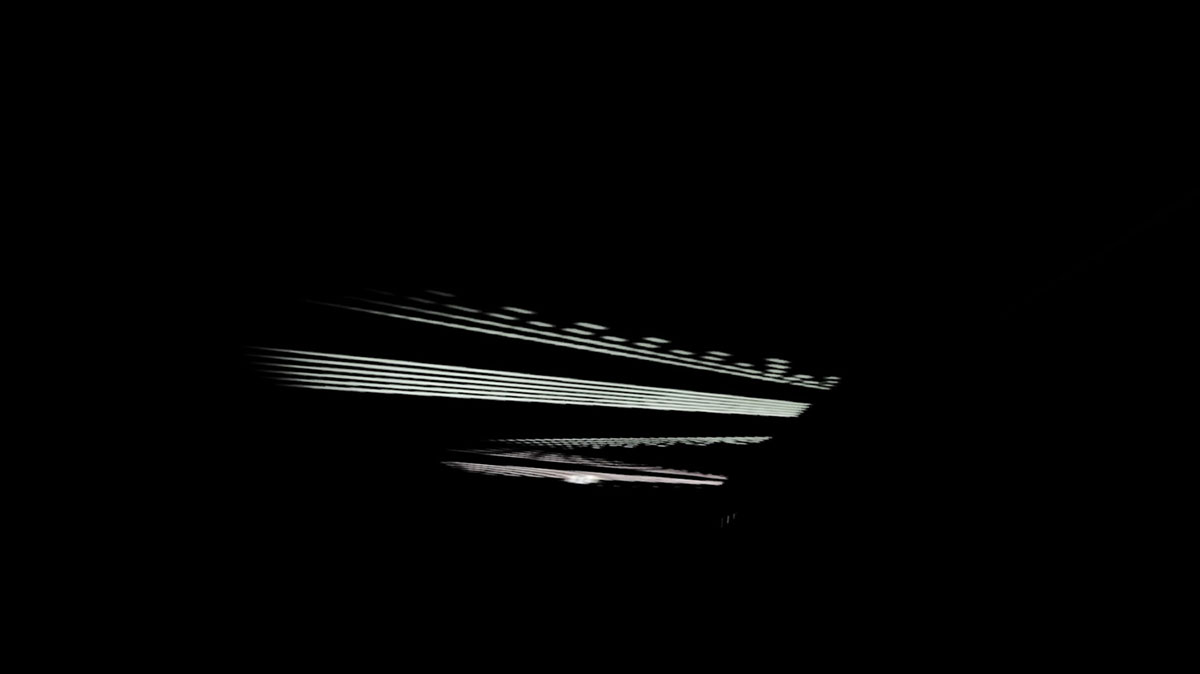 Emily Wardill’s works are best known for their sensual and psychologically charged refracted narratives. Wardill’s films, photographic works, drawings, and props investigate the complexities of communication and representation, the limitations and imprecision of language, and the point at which the immaterial adopts the material through insinuation. For the exhibition “Sleep Patterns and Musical Chairs”, the artist presents a two-projection installation with the same title, that takes the imaginary of the nation state – projecting the patterns that car headlights make on our ceiling at night whilst musical hallucinations of national anthems bleed in through the space. The architecture becomes a part of the piece through these accidental moving highlights that make us think of not being able to sleep whilst pointing towards a fake origin – the cars never existed and are represented through a remnant without an original. The soundtrack is composed from distorted national anthems that fight with each other, change keys and speeds to sound intoxicated, puzzle themselves into logics that wrap around into nothingness and descend into enthusiastic destruction (played on the piano by Daniel Bernardes). Info: carlier|gebauer, Calle de José Marañón 4, Madrid, Spain, Duration: 2/12/2023-20/1/2024, Days & Hours: Tue-Fri 11:00-19:00, Sat 11:00-14:00, www.carliergebauer.com/current
Emily Wardill’s works are best known for their sensual and psychologically charged refracted narratives. Wardill’s films, photographic works, drawings, and props investigate the complexities of communication and representation, the limitations and imprecision of language, and the point at which the immaterial adopts the material through insinuation. For the exhibition “Sleep Patterns and Musical Chairs”, the artist presents a two-projection installation with the same title, that takes the imaginary of the nation state – projecting the patterns that car headlights make on our ceiling at night whilst musical hallucinations of national anthems bleed in through the space. The architecture becomes a part of the piece through these accidental moving highlights that make us think of not being able to sleep whilst pointing towards a fake origin – the cars never existed and are represented through a remnant without an original. The soundtrack is composed from distorted national anthems that fight with each other, change keys and speeds to sound intoxicated, puzzle themselves into logics that wrap around into nothingness and descend into enthusiastic destruction (played on the piano by Daniel Bernardes). Info: carlier|gebauer, Calle de José Marañón 4, Madrid, Spain, Duration: 2/12/2023-20/1/2024, Days & Hours: Tue-Fri 11:00-19:00, Sat 11:00-14:00, www.carliergebauer.com/current
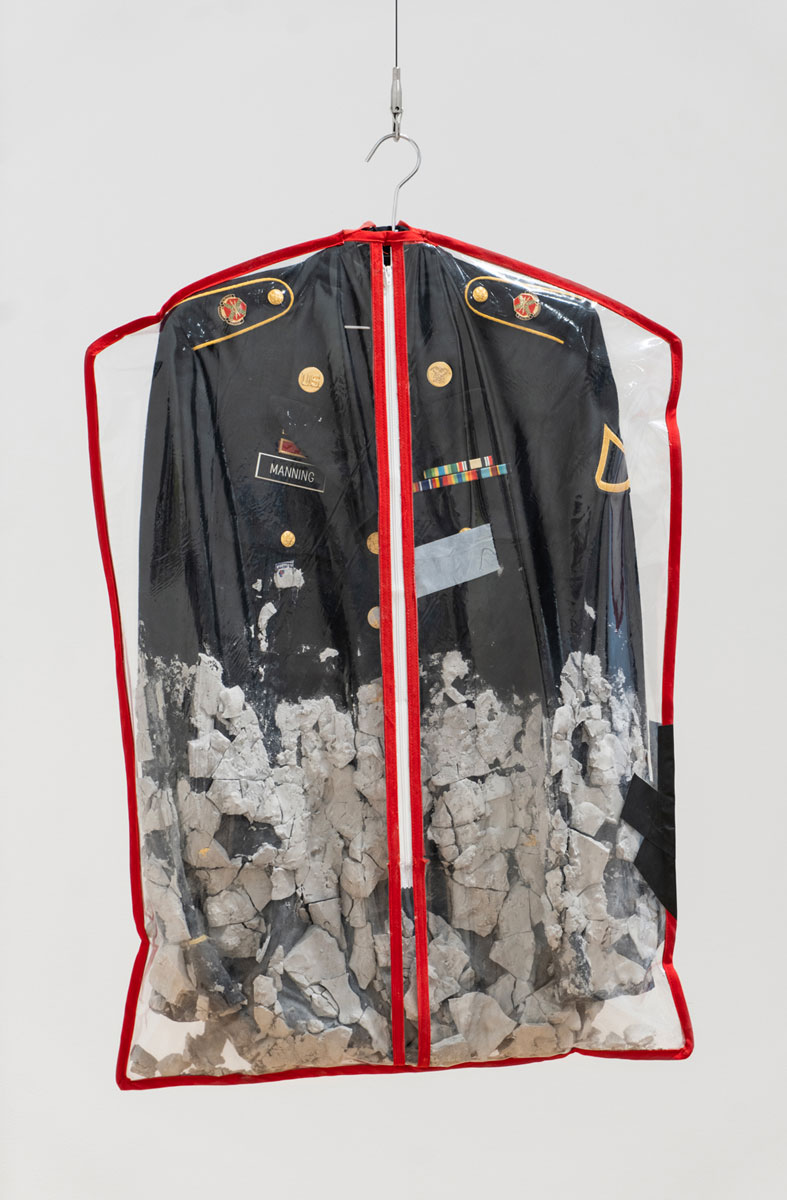 A.K. Burns’ exhibition showcases a selection of recent works from sculptures to wall works, and collages. “Sunset at Scum Pond” is experienced in the haze of the waning sun as the threshold of night lingers. The ponds reflective surface is muddled by the craggy and vital matter that collects on its placid surface. Under the darkening sky the waters absorb the last flickers of light into the murky void. The central works on display are a series of collages composed on the surface of mirrors that are presented in groups of seven. Each group corresponds to one of four video installations that make up the “Negative Space” tetralogy an incorporate visual research informing various scenes depicted in the videos, with elements of print and digital sources providing an “associative atlas” that symbolically maps each work. Also on view are Burns’ newest works “Split Tongue (2023)” a pair of mural sculptures made from industrial black tarps transformed through a tailoring technique called ‘rouching’ that evoke the ruffled layers of a dress shirt. Formally, the works hold binary qualities—masculine and feminine—in one gesture that is split open along a central zipper. Appearing like giant bifurcated tongues they reference a larger shift towards polarizing speech that has created widening cultural and political divisions. Info: Michel Rein Gallery, 42 rue de Turenne, Paris, France, Duration: 2/12/2023-13/1/2024, Days & Hours: Tue-Sat 11:00-19:00, https://michelrein.com/
A.K. Burns’ exhibition showcases a selection of recent works from sculptures to wall works, and collages. “Sunset at Scum Pond” is experienced in the haze of the waning sun as the threshold of night lingers. The ponds reflective surface is muddled by the craggy and vital matter that collects on its placid surface. Under the darkening sky the waters absorb the last flickers of light into the murky void. The central works on display are a series of collages composed on the surface of mirrors that are presented in groups of seven. Each group corresponds to one of four video installations that make up the “Negative Space” tetralogy an incorporate visual research informing various scenes depicted in the videos, with elements of print and digital sources providing an “associative atlas” that symbolically maps each work. Also on view are Burns’ newest works “Split Tongue (2023)” a pair of mural sculptures made from industrial black tarps transformed through a tailoring technique called ‘rouching’ that evoke the ruffled layers of a dress shirt. Formally, the works hold binary qualities—masculine and feminine—in one gesture that is split open along a central zipper. Appearing like giant bifurcated tongues they reference a larger shift towards polarizing speech that has created widening cultural and political divisions. Info: Michel Rein Gallery, 42 rue de Turenne, Paris, France, Duration: 2/12/2023-13/1/2024, Days & Hours: Tue-Sat 11:00-19:00, https://michelrein.com/
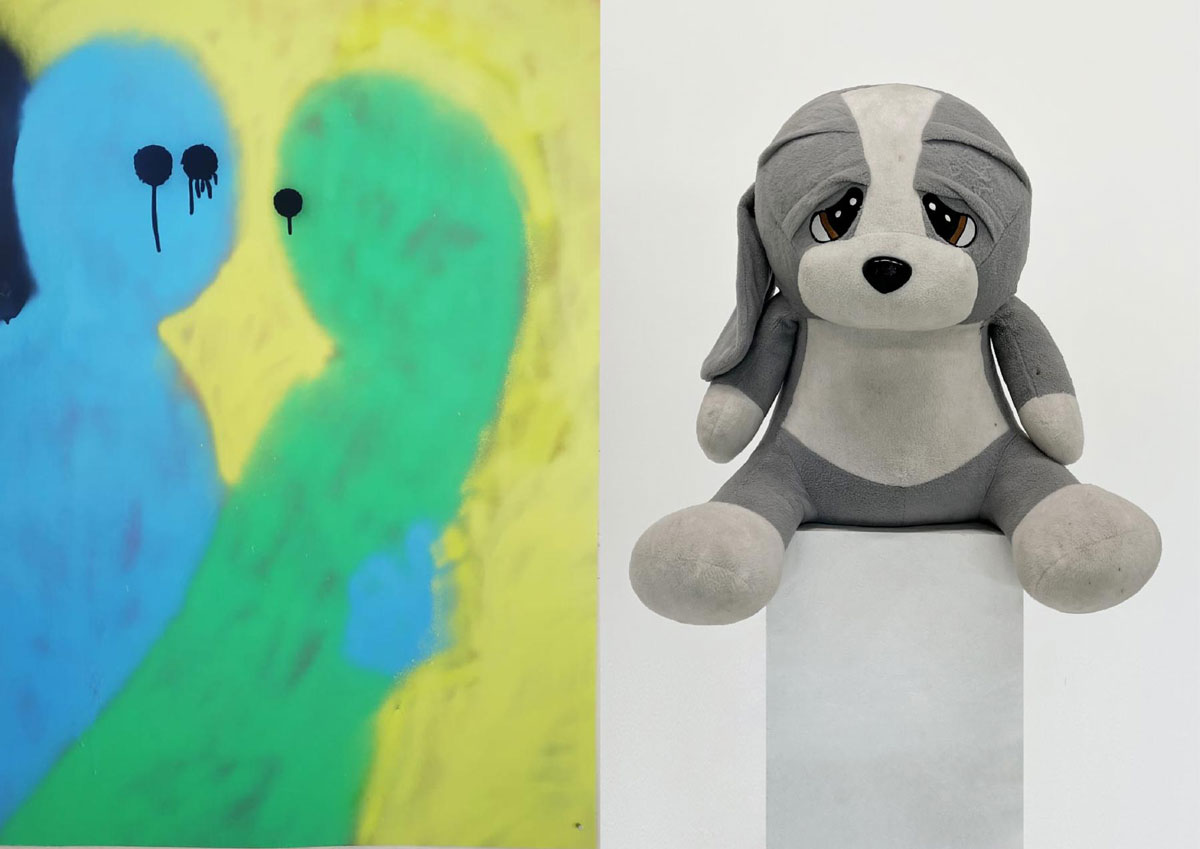 The exhibition “Sono Andati” draws inspiration from Giacomo Puccini’s opera “La Bohème,” particularly the heart-wrenching aria “Sono andati.” Featuring the works of Kévin Blinderman and Adrien Fregosi, two artists who weave together an emotional and aesthetic experience ultimately underscoring the fra gile and impermanent nature of life itself. Their works evoke a violently conflicting mix of emotions, much like “La Bohème” straddles the delicate boundary between comedy and tragedy. Within the brushstrokes and sculptures an encounter of bittersweet beauty, poignant portrayal of love, sacrifice, and illness offering a contemplative space for viewers to explore the delicate interplay of clashing mix of emotions that mirrors the timeless sentiments f ound in Puccini’s masterpiece. This exhibition spans both floors of the Sultana gallery. On the first floor, Adrien Fregosi’s paper paintings adorn the walls, setting a captivating backdrop for Kévin Blinderman’s objet trouvé, a charming peluche displayed prominently on a pedestal. Transitioning to the lower floor, visitors will encounter Kévin’s sound installation, specially conceived for this exhibition, as the space becomes an acoustic vessel for melancholic narratives. Encircling this auditory experience are three new paintings that represent a new direction in the artist’s practice. Info: Curators: by Valentina Rosas & Guillaume Sultana, Galerie Sultana, 75 Rue Beaubourg, Paris, France, Duration: 2/12/2023-6/1/2024, Days & Hours: Tue-Sat 11:00-19:00, https://galeriesultana.com/
The exhibition “Sono Andati” draws inspiration from Giacomo Puccini’s opera “La Bohème,” particularly the heart-wrenching aria “Sono andati.” Featuring the works of Kévin Blinderman and Adrien Fregosi, two artists who weave together an emotional and aesthetic experience ultimately underscoring the fra gile and impermanent nature of life itself. Their works evoke a violently conflicting mix of emotions, much like “La Bohème” straddles the delicate boundary between comedy and tragedy. Within the brushstrokes and sculptures an encounter of bittersweet beauty, poignant portrayal of love, sacrifice, and illness offering a contemplative space for viewers to explore the delicate interplay of clashing mix of emotions that mirrors the timeless sentiments f ound in Puccini’s masterpiece. This exhibition spans both floors of the Sultana gallery. On the first floor, Adrien Fregosi’s paper paintings adorn the walls, setting a captivating backdrop for Kévin Blinderman’s objet trouvé, a charming peluche displayed prominently on a pedestal. Transitioning to the lower floor, visitors will encounter Kévin’s sound installation, specially conceived for this exhibition, as the space becomes an acoustic vessel for melancholic narratives. Encircling this auditory experience are three new paintings that represent a new direction in the artist’s practice. Info: Curators: by Valentina Rosas & Guillaume Sultana, Galerie Sultana, 75 Rue Beaubourg, Paris, France, Duration: 2/12/2023-6/1/2024, Days & Hours: Tue-Sat 11:00-19:00, https://galeriesultana.com/
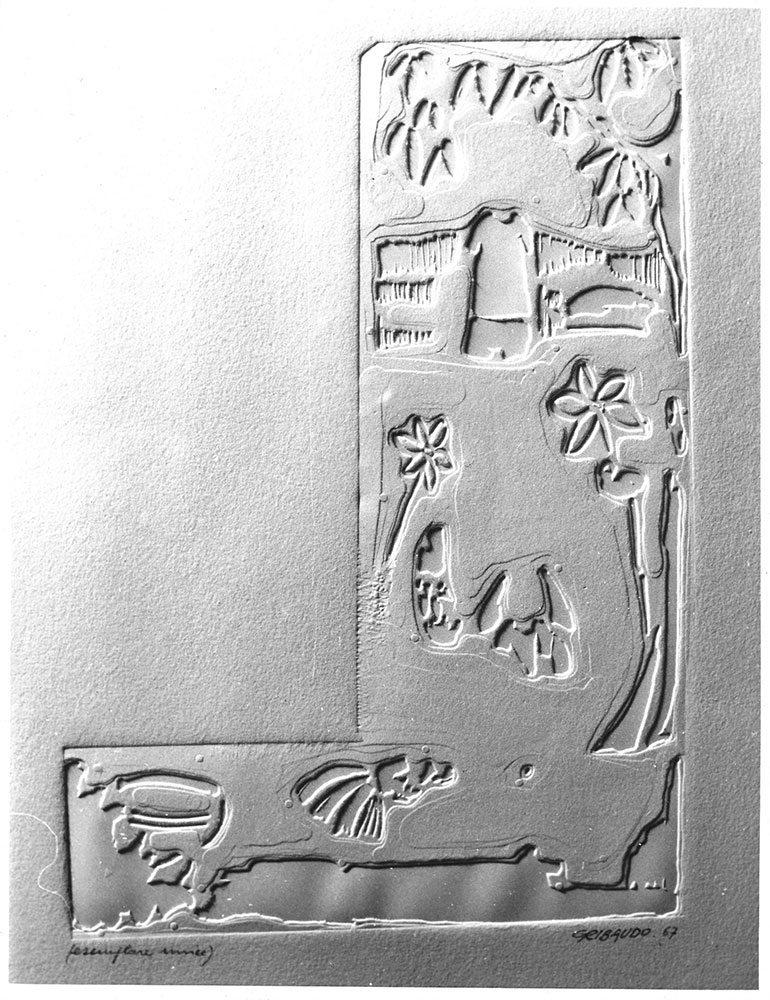 “The Weight of the Concrete” marks the first monographic exhibition of Ezio Gribaudo in Austria. It serves as a comprehensive homage to his multifaceted career, offering an extensive exploration of his roles as both artist and publisher. The exhibition borrows its name from “Il Peso del Concreto”” (1968), a seminal book that featured Gribaudo’s early graphic work alongside an anthology of concrete poetry edited by the poet Adriano Spatola. In line with his interdisciplinary approach, this exhibition explores Gribaudo’s idiosyncratic oeuvre, his poetics of matter, and the complex relationship he developed between image and language. At the center of the exhibition are the “Logogrifi”, Gribaudo’s emblematic series that he developed from the 1960s onward. Throughout his life, the “Logogrifi” have articulated a deep entanglement with his activities as a bookmaker, as well as his fascination for new industrial printing processes, typefaces, language games, and relief matrices. Grounded in linguistic or visual riddles, the “Logogrifi” are akin to logogriphs or puzzles that involve the formation of new words by permuting their initial letter. Info: Curators: Tom Engels and Lilou Vidal, Grazer Kunstverein, Palais Trauttmansdorff, Burggasse 4, Graz, Austria, Duration: 8/12/2023-2/3/2024, Days & Hours: Wed-Sun 12:00-18:00, www.grazerkunstverein.org/
“The Weight of the Concrete” marks the first monographic exhibition of Ezio Gribaudo in Austria. It serves as a comprehensive homage to his multifaceted career, offering an extensive exploration of his roles as both artist and publisher. The exhibition borrows its name from “Il Peso del Concreto”” (1968), a seminal book that featured Gribaudo’s early graphic work alongside an anthology of concrete poetry edited by the poet Adriano Spatola. In line with his interdisciplinary approach, this exhibition explores Gribaudo’s idiosyncratic oeuvre, his poetics of matter, and the complex relationship he developed between image and language. At the center of the exhibition are the “Logogrifi”, Gribaudo’s emblematic series that he developed from the 1960s onward. Throughout his life, the “Logogrifi” have articulated a deep entanglement with his activities as a bookmaker, as well as his fascination for new industrial printing processes, typefaces, language games, and relief matrices. Grounded in linguistic or visual riddles, the “Logogrifi” are akin to logogriphs or puzzles that involve the formation of new words by permuting their initial letter. Info: Curators: Tom Engels and Lilou Vidal, Grazer Kunstverein, Palais Trauttmansdorff, Burggasse 4, Graz, Austria, Duration: 8/12/2023-2/3/2024, Days & Hours: Wed-Sun 12:00-18:00, www.grazerkunstverein.org/
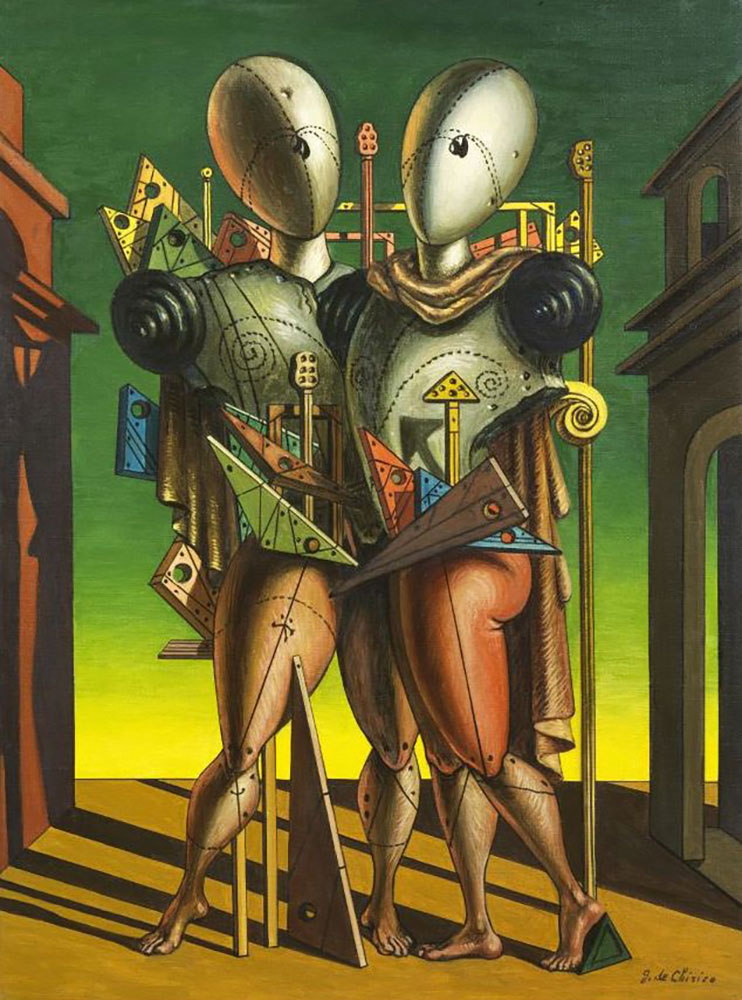 Α retrospective is dedicated to Giorgio de Chirico, one of the most emblematic figures in the artistic and cultural debate of the 20th century. Rome was dear to the Pictor Optimus (Latin for “the best painter”): here he studied ancient ruins, he was fascinated by Raphael’s School of Athens in the Vatican Rooms and he deepened aspects of his metaphysical painting. He moved there permanently in 1944 and from 1948 settled with his wife in the house-studio in Piazza di Spagna – which now hosts the Giorgio and Isa de Chirico Foundation – a strategic position in the artistic heart of the city, with the ateliers on Via Margutta and Via del Babuino, the Caffè Greco on Via Condotti and the Caffè Aragno on Via del Corso. On display is a selection of more than thirty works – including painting, sculpture, drawing and arras-, from the early 20th century to the 1970s, which gives an almost complete idea of the artist’s production phases. Info: Tornabuoni Art, Via Bocca di Leone 88, Rome, Italy, Duration: 7/12/2023-24/2/2024, Days & Hours: Tue-Sat 10:00-13:00 & 14:00-19:00, www.tornabuoniart.com/
Α retrospective is dedicated to Giorgio de Chirico, one of the most emblematic figures in the artistic and cultural debate of the 20th century. Rome was dear to the Pictor Optimus (Latin for “the best painter”): here he studied ancient ruins, he was fascinated by Raphael’s School of Athens in the Vatican Rooms and he deepened aspects of his metaphysical painting. He moved there permanently in 1944 and from 1948 settled with his wife in the house-studio in Piazza di Spagna – which now hosts the Giorgio and Isa de Chirico Foundation – a strategic position in the artistic heart of the city, with the ateliers on Via Margutta and Via del Babuino, the Caffè Greco on Via Condotti and the Caffè Aragno on Via del Corso. On display is a selection of more than thirty works – including painting, sculpture, drawing and arras-, from the early 20th century to the 1970s, which gives an almost complete idea of the artist’s production phases. Info: Tornabuoni Art, Via Bocca di Leone 88, Rome, Italy, Duration: 7/12/2023-24/2/2024, Days & Hours: Tue-Sat 10:00-13:00 & 14:00-19:00, www.tornabuoniart.com/
